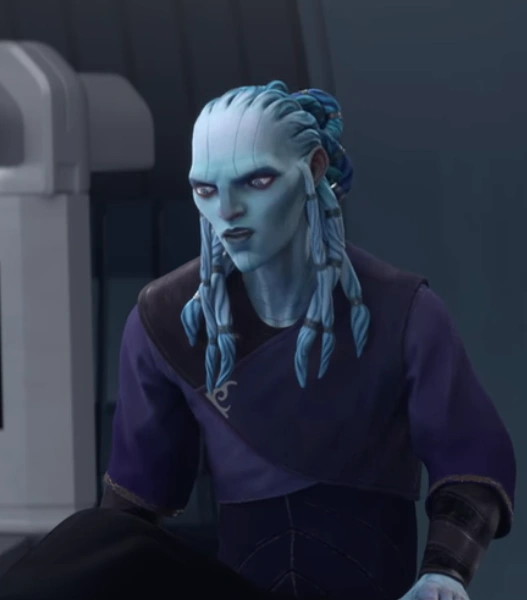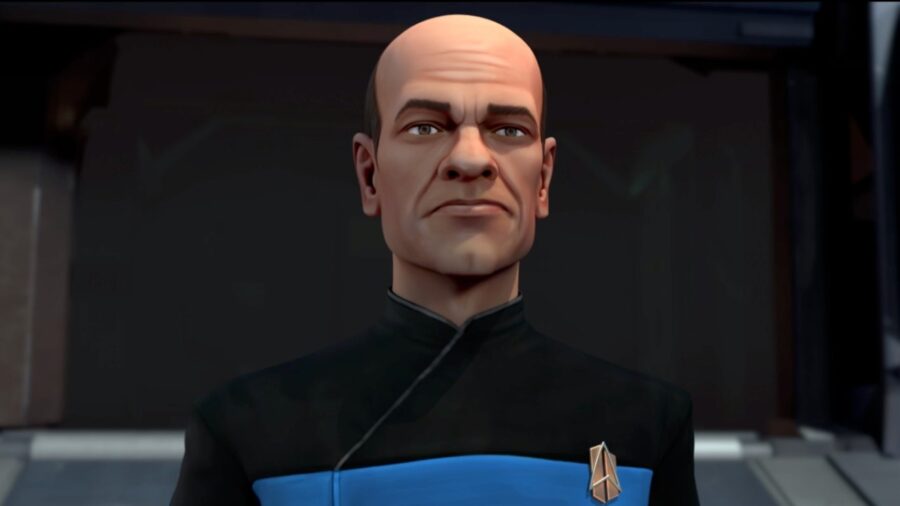The title refers to the time dilation effect on Dilmer III, and is a pun on either fully dilated pupils in drug use or fully dilated cervixes in labor, or both.
The stardate is 59499.6. The dimensional fissures leading to parallel dimensions have been a recurring thing this season, starting with LD: “Dos Cerritos”.
The purple Enterprise is a Galaxy-class, meaning Enterprise-D. In the Prime Universe, by 2381 the 1701-D had already crashed on Veridian III and the Sovereign-class Enterprise-E had been in service for about a decade. Tashar Yar was the original security chief of Enterprise-D, but was killed in TNG: “Skin of Evil”. No, I’m not getting into TNG: “Yesterday’s Enterprise” and Sela now, so don’t ask. Mariner talks about the carpets on Enterprise-D, a running joke that was even echoed in PIC’s 3rd season when the reconstructed ship was reactivated (PIC: “Võx”).
T’Lyn says her home was an outcopping of jagged rocks in the Viltan Flats. That location originally comes from the Last Unicorn RPG module The Way of Kolinahr, and is in the province of Tat’Sahr on Vulcan.
Boimler’s beard has progressed further, and the goatee has almost joined with his moustache. Rutherford seems to be also getting into the game, if his stubble is any indication. Freeman’s order to retrieve the wayward tech is so as not to violate the Prime Directive, which forbids any interference with the natural technological or social development of a civiilization. Dilmer III is pre-industrial, so the Prime Directive is in full force.
Dr T’Ana does a more foul mouthed version of the classic “I’m a doctor, not a…” catchphrase first properly used by McCoy in TOS: “The Devil in the Dark”.
Undergoing temporary surgical or genetic modification for Starfleet away teams is standard protocol. Examples can be found in TNG: “Who Watches the Watchers?”, TNG: “First Contact” and in SNW: “Strange New Worlds”.
Vulcans are known to have sensitive olfactory senses. females especially. In ENT: “The Andorian Incident”, T’Pol used a regularly injected nasal numbing agent to suppress the smell of humans.
Rutherford jokes about churning your own butter, a reference to stereotypes of primitive, pioneer peoples (seen today in renactments or in communities like the Amish) who still manufacture butter with manual methods.
A michelada is an Mexican drink, often called a “Mexican Bloody Mary”, made from beer, lime juice, hot sauces and chili slices. There are several variations throughout Mexico, but Boimler and Rutherford’s version is a bit excessive, as is usual for them.
Dimler III has a time differential of a week on the surface for every second aboard ship. As Tendi remembers, in VOY: “Blink of an Eye”, Voyager came across a planet surrounded by a tachyon field that experienced 58 days for each minute of shipboard time. Mariner’s explanation of time dilation alludes to an old joke attributed to Einstein: “Put your hand on a hot stove for a minute, and it seems like an hour. Sit with a pretty girl for an hour, and it seems like a minute. That's relativity.”
The architecture of Dimler III reminds me of Beta III in TOS: “The Return of the Archons”, but earlier - I’d peg it around an 1870s American frontier town, like Walnut Grove, MI in Little House on the Prairie.
The head they find is of course that of an alternate, purple Data, who also lost his head in TNG: “Time’s Arrow”. In the Prime Universe, at this point Prime Data is dead, having sacrificed himself in Nemesis (2379) - although as we see in PIC, he kind of gets better later.
T’Lyn poses as a traveling performer, much like what Picard & Co. did in “Time’s Arrow” when they claimed to be a troupe of actors. Snell is voiced by Eric Bauza, who does a great imitation of the immortal Wallace Shawn, who was Grand Nagus Zek in DS9 and is probably best known to geeks as Visini from The Princess Bride.
As Tendi notes, TNG-era Romulan uniforms had hilariously overpadded shoulders. Mariner refers to TNG: “The Inner Light” when Picard was hit by a beam from a Kataan probe which made him experience an entire lifetime as a Kataan farmer while only a matter of minutes passed for his crew (and learned the flute). The last time we saw a Kataan probe (or something very similar) was in LD: “In the Cradle of Vexilon”.
Mariner refers to ENT: “Carbon Creek”, when a trio of Vulcans - one of them T’Pol’s great-grandmother - were stranded temporarily in Carbon Creek, PA in 1957. While it is true that in most stories like this there is a suspicious neighbor that gets the protagonists in trouble, I don’t recall there one being in “Carbon Creek”. T’Lyn uses a quill to write.
Purple Data’s voice is provided by Brent Spiner. He says he has been just a head before, which means that the events of “Time’s Arrow” also occured in his reality (as he confirms later when he says he built a magnetic field core in 19th Century San Francisco).
Tendi says that Orions aren’t usually science officers (part of it may be due to the stereotypes surrounding Orions). Her great-grandmother Astrea did serve on the Orion science vessel D’Var (SNW: “Those Old Scientists”).
Purple Data alludes to his positronic matrix, which is also the basis for Soong-type androids in the Prime Universe. Positronic brains for artificial beings in Star Trek is a homage to the works of Isaac Asimov, who used such brains for his robots in his Robot Stories.
The alien writing on the front of the saloon I’m pretty sure is a substitution alphabet (like Orionese as seen in LD: “Something Borrowed, Something Green”) which just reads “SALOON”.
I’m also pretty sure Tendi saying that she can’t compete with T’Lyn’s giant melons is an intentional double entendre. Others include Ransom’s “Purple D” and Mariner’s “carpet matches the hull” lines.
Mariner refers to the Edo (TNG: “Justice”), who doled out what we might consider overly harsh punishments, like capital punishment for damaging plants.
Purple Data says Tendi requires her full strength to function at “peak performance”, which is the name of a TNG episode that focuses on Prime Data and his self-doubt when he experiences defeat.
The “guy in a silver jumpsuit” was the unnamed scientist that led Picard and Prime Data to his time-displaced buried head under San Francisco (“Time’s Arrow”).
Tendi says Purple Data really is “fully functional”. In the infamous TNG: “The Naked Now”, Prime Data claims, when an intoxicated Tasha Yar is trying to seduce him, that he is “fully functional” and “programmed in multiple techniques”.
Mariner’s cell neighbor calls her “Big Mare”. In LD: “Starbase 80?!” Boimler calls her “Mare Bear”. I am not comfortable with either of these nicknames.
Having her alien family “be here all along” is a common trope (The Wizard of Oz comes to mind) where protagonists realize that what they were seeking was actually around them all the time (“The true treasure was the friends we made along the way!”).
Purple Data misunderstanding the use of metaphor is a trait the Prime version often exhibted, especially in early TNG seasons. And of course he had a close relationship with Geordi La Forge, the Chief Engineer of Enterprise.
Rutherford blames the snafu on LCARS issues, LCARS (Library Computer Access and Retrieval System) being the operating system used on TNG-era starships, as opposed to S/COMS for ENT and TOS-era ships and TCARS for 29th Century timeships.
Purple Data says he spent a year in the field with the away team. 12 months or so on Dimler III translates to about 52 seconds in shipboard time. However, considering that Tendi didn’t reactivate the head until about 4 months in, the time could have been as long as 16 months (64 seconds).
Freeman sends Purple Data back through the fissure in a photon torpedo tube, much like how Spock’s body was shot towards the Genesis Planet at the end of ST II.This guy





